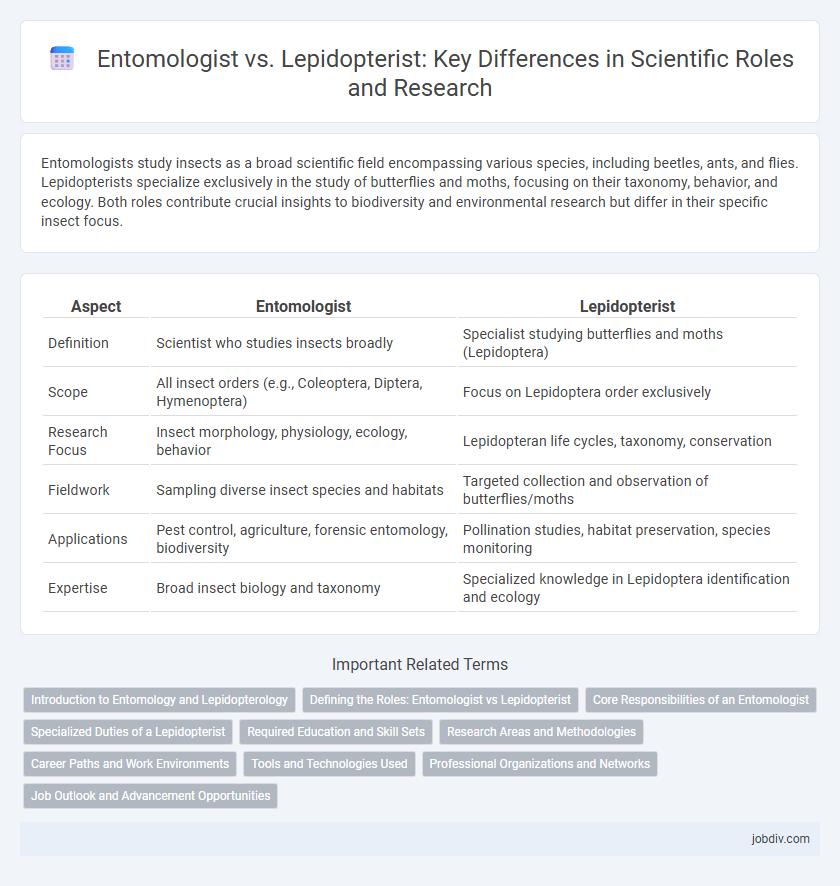Entomologists study insects as a broad scientific field encompassing various species, including beetles, ants, and flies. Lepidopterists specialize exclusively in the study of butterflies and moths, focusing on their taxonomy, behavior, and ecology. Both roles contribute crucial insights to biodiversity and environmental research but differ in their specific insect focus.
Table of Comparison
| Aspect | Entomologist | Lepidopterist |
|---|---|---|
| Definition | Scientist who studies insects broadly | Specialist studying butterflies and moths (Lepidoptera) |
| Scope | All insect orders (e.g., Coleoptera, Diptera, Hymenoptera) | Focus on Lepidoptera order exclusively |
| Research Focus | Insect morphology, physiology, ecology, behavior | Lepidopteran life cycles, taxonomy, conservation |
| Fieldwork | Sampling diverse insect species and habitats | Targeted collection and observation of butterflies/moths |
| Applications | Pest control, agriculture, forensic entomology, biodiversity | Pollination studies, habitat preservation, species monitoring |
| Expertise | Broad insect biology and taxonomy | Specialized knowledge in Lepidoptera identification and ecology |
Introduction to Entomology and Lepidopterology
Entomology encompasses the scientific study of insects, covering their taxonomy, behavior, and ecology. Lepidopterology, a specialized branch within entomology, focuses specifically on the study of butterflies and moths, analyzing their morphology, life cycles, and environmental interactions. Researchers in both fields utilize methods such as field observation, specimen collection, and genetic analysis to advance knowledge of insect biodiversity and conservation.
Defining the Roles: Entomologist vs Lepidopterist
Entomologists specialize in the study of insects, encompassing a broad range of species including beetles, ants, and flies, while lepidopterists focus specifically on the order Lepidoptera, which includes butterflies and moths. Lepidopterists often analyze butterfly and moth behavior, life cycles, and ecological impacts within ecosystems, contributing valuable insights to biodiversity and conservation efforts. Entomologists employ a wider scope of research methodologies to explore insect physiology, taxonomy, and interactions, supporting advancements in agriculture, pest control, and environmental science.
Core Responsibilities of an Entomologist
Entomologists study a wide range of insects, analyzing their behavior, ecology, physiology, and taxonomy to understand their roles in ecosystems, agriculture, and human health. They conduct field research and laboratory experiments to identify pest species, develop pest control methods, and contribute to biodiversity conservation. Unlike lepidopterists, who specialize exclusively in butterflies and moths, entomologists cover all insect orders, providing broader insights into insect biology and environmental impact.
Specialized Duties of a Lepidopterist
Lepidopterists specialize in the study of butterflies and moths, focusing on their life cycles, behavior, and ecological roles. Their duties involve detailed field observations, specimen collection, and taxonomic classification within the order Lepidoptera. This specialization requires expertise in identifying species-specific characteristics, habitat preferences, and evolutionary patterns distinct from the broader scope of entomologists.
Required Education and Skill Sets
Entomologists typically require a bachelor's degree in entomology, biology, or a related field, with advanced research roles demanding a master's or Ph.D. in entomology, emphasizing skills in taxonomy, ecology, and pest management. Lepidopterists, specializing in butterflies and moths, also pursue degrees in biology or entomology but develop specialized skills in lepidopteran taxonomy, species identification, and habitat conservation. Both fields require proficiency in field sampling techniques, data analysis, and scientific communication to contribute effectively to ecological research and biodiversity studies.
Research Areas and Methodologies
Entomologists study a broad range of insects across various orders, employing diverse methodologies such as field sampling, morphological analysis, and genetic sequencing to understand insect behavior, ecology, and physiology. Lepidopterists specialize specifically in butterflies and moths, focusing their research on life cycle stages, habitat preferences, and species interactions using techniques like pheromone trapping, larval rearing, and detailed wing pattern analysis. Both disciplines contribute to biodiversity conservation but differ in scope and specialized research tools tailored to their target insect groups.
Career Paths and Work Environments
Entomologists study a broad range of insect species across diverse environments, including agricultural fields, forests, and laboratories, focusing on insect behavior, ecology, and pest control. Lepidopterists specialize in the study of butterflies and moths, often conducting field research in habitats rich in lepidopteran diversity such as meadows, woodlands, and conservation areas. Both career paths involve scientific research, specimen collection, and data analysis, but lepidopterists typically narrow their scope to lepidoptera taxonomy, life cycles, and conservation biology.
Tools and Technologies Used
Entomologists employ a wide range of tools such as sweep nets, pitfall traps, and microscopes to study diverse insect species across various environments. Lepidopterists specifically utilize specialized light traps, nets designed for delicate handling, and high-resolution imaging technology to capture and analyze butterflies and moths. Both fields increasingly incorporate molecular techniques like DNA barcoding for precise species identification and ecological research.
Professional Organizations and Networks
Entomologists often engage with professional organizations such as the Entomological Society of America (ESA), which provides extensive resources, research publications, and networking opportunities across all insect-related disciplines. Lepidopterists typically participate in specialized groups like the Lepidopterists' Society, offering focused forums for the study of butterflies and moths, including access to niche journals and field study collaborations. Both fields benefit from interdisciplinary networks but maintain distinct professional ecosystems to advance species-specific research and conservation efforts.
Job Outlook and Advancement Opportunities
Entomologists have a broader scope covering all insect species with job growth projected at 5% over the next decade, driven by agricultural research and pest control needs. Lepidopterists, specializing in butterflies and moths, face narrower career opportunities typically within academic research or conservation, with fewer positions available. Advancement for entomologists often includes leadership roles in environmental consulting or government agencies, while lepidopterists may advance through niche scientific publications or museum curation.
Entomologist vs Lepidopterist Infographic

 jobdiv.com
jobdiv.com